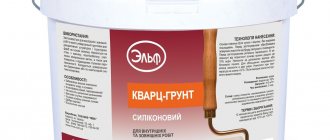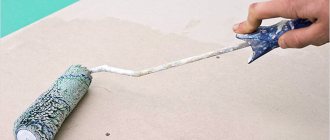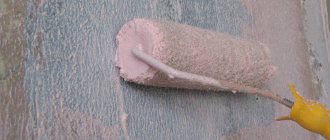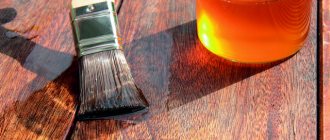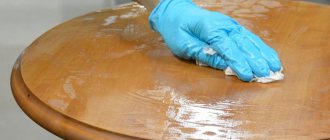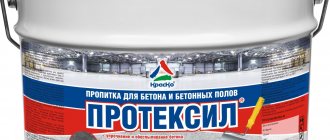What is a deep penetration primer
The basis of the repaired surfaces can be different materials - wood, concrete, cement-sand or gypsum plaster. Their properties are different, so their adhesion to the finish will be different. To make it as durable as possible, use a primer. This is impregnation for walls, which can penetrate to a depth of 5-10 mm. It is represented by a wide range on the building materials market. Separately, it is worth noting that it is universal - it is suitable for almost any surface.
Perchlorovinyl primer
Designed for impregnation of brick, metal, plastered and concrete surfaces. Dries phenomenally quickly. Feature: excellent adhesion to subsequent finishing. However, it interacts best with perchlorovinyl resin based paints.
Compound:
- perchlorovinyl resin;
- fillers;
- alkyd resin;
- epoxy resin;
- additives that prevent corrosion.
Like glyphthalic, it belongs to the group of alkyd primers. Drying time is only 1 hour, even at temperatures well below 0°C. Perchlorovinyl primer is toxic.
Scope of application
Deep penetration primers fill the porous structure of concrete, making it more resistant to external influences and increasing adhesion to finishing materials.
Concrete has a very high density, hence very low absorbency. Therefore, plastering or painting such a surface without prior preparation will not be effective.
Such compositions will be the only right choice if you plan to use heavy wallpaper as interior decoration - not a single glue can hold the sheets on a concrete wall.
Despite their intended purpose, concrete primers can be used on:
- plastered walls;
- drywall;
- brick;
- gas blocks;
- foam concrete blocks.
Due to their properties, the compositions of this group are rightfully considered universal.
Primers with high penetrating ability are ideal for preparing substrates in areas with high levels of humidity - in bathrooms and kitchens. Here the walls are constantly in contact with moisture, which can cause the appearance of fungus and wall mold.
A primer containing antiseptic substances is guaranteed to prevent the development of pathogenic microflora.
Ceresit
The Ceresit brand is directly related to, which was founded back in the 19th century. The company's products are manufactured in many countries. Over more than a hundred years of its existence, the process of producing building mixtures has undergone technological changes and is constantly evolving.
Now on the finishing materials market you can buy Ceresit penetrating emulsion with an extended shelf life from 12 to 24 months.
Technical characteristics of Ceresit:
- air temperature during operation from 5 to 35C with a + sign;
- film color is pale yellow;
- drying time when diluted is about 2-4 hours;
- There is a frost-resistant version;
- penetration into the base from 0.5 to 1.5 mm depending on its type;
- consumption 150 ml per 1m2;
Ceresit primer is sold in concentrated form and diluted with clean water. The proportions will depend on the type of surface, they will range from 1:4 to 1:9.
More water will be required for gypsum and cement plasters. Less dilution is for cement screeds under floor leveling mixtures.
Ceresit
After drying, the primer has no odor.
It is absolutely harmless, including for children, so it can be used to treat walls or other surfaces in children's institutions.
The primer is suitable for treating the following surfaces:
- concrete;
Concrete
- cement plaster;
Cement plaster
- gypsum plaster;
Gypsum
- ceramic and silicate bricks;
Brick
- Chipboard, fibreboard, plasterboard.
Chipboard
Processing of cellular concrete will require double priming. During the first treatment, the emulsion is more diluted. Also used for processing lime and gypsum plasters both outside and inside the building.
The penetrating solution strengthens the surface, guarantees uniform distribution of floor mixtures, prevents the appearance of air bubbles and increases adhesion to finishing solutions.
Functional purpose
As you know, concrete is a material with high density and hardness, but at the same time it contains micropores. The porous structure has both its advantages and disadvantages. In particular, if the concrete surface is left as is, then its pronounced absorbent ability leads to increased costs of paint and varnish products. A primer with a deep penetration effect is a special composition that gets into micropores. This allows you to strengthen the concrete from the inside, and at the same time increase its adhesive properties. As a rule, this is achieved through acrylic polymers, which are rich in some types of deep penetration primers for concrete. When using them, along with the strengthening effect, the absorbency of the building material decreases.
Primer mixtures are used for exterior or interior finishing. After surface treatment, other types of finishing can be used: putty; tiling; paint and varnish products; plaster (including decorative); wallpaper (including liquid). In this case, the primer makes it possible to apply subsequent finishing materials in an even layer. Based on this, it becomes clear that the application of such compounds is a necessary and important process.
Epoxy primer
The main structural element is epoxy resin. Thanks to it, the treated base is characterized by better adhesion, temperature resistance and resistance to mechanical stress.
Most often, epoxy primer is a one- or two-component mixture.
Compound:
- Epoxy resins;
- Substances that increase strength and adhesion.
Some epoxy primers may contain solvents.
Epoxy primer is very often used for concrete type foundations, including reinforced concrete, as well as metal surfaces. Drying time – 12 hours.
general information
Primers perform the following functions: Reduce the absorption of finishing materials because they fill the surface pores. As a result, the paint, varnish or glue is not wasted, but remains on the surface of the material. Increase adhesion (the ability of materials to adhere). Although it is worth making a reservation here: if we are talking about cement plaster, then the adhesive properties will become worse, since the cement laitance will not be absorbed into the pores - after all, they will already be filled with primer. They strengthen the base, penetrating deep into the structure of loose and porous surfaces. The soil seems to connect the disparate elements of the base with each other. The likelihood of plastered surfaces falling off, whitewash peeling off, mortar chipping at the seams, etc. is reduced.
Latex primer
It belongs to the water-soluble group, which makes it safe. After drying, it forms a matte, vapor-permeable film. Usually available as a one-component mixture.
Compound:
- styrene acrylic latex;
- defoaming agents;
- antiseptics;
- fillers;
- modifying additives;
- preservatives.
The primer has found its application for the treatment of internal surfaces, in particular the treatment of loose, old, crumbling and porous bases of concrete, brick, plaster, plasterboard and putty. Most often used for plasters, putties, tile or wallpaper adhesive, as well as paint.
Compound
The composition of deep-penetrating primers includes the following components: Water. Only water-based primers are offered on the Russian market. Acrylic resins. They act as a connecting element. Polymers. They provide good moisture to the treated coating and allow the soil to penetrate to maximum depth. As an option, the following components can be added to the soil: Fungicides, which act as an antiseptic.
The antiseptic properties of the soil help prevent the occurrence of mold and mildew. Such mixtures are especially useful if the surface will be used in conditions of high humidity. Latex, which allows you to increase the adhesion of small surfaces. Latex also improves the adhesion of low-porosity materials. Silicone makes the base waterproof.
Peculiarities
The surface of concrete, brick, and other mineral materials is highly susceptible to the influence of external factors, especially moisture. It is easily absorbed into the porous structure and starts the process of slow destruction of the structure of the material.
If weather conditions are favorable and moisture also manages to freeze in the pores, it simply tears the surface from the inside. After several such influences, the building structure will become completely unusable.
Primer for concrete is an effective barrier to the influence of external factors. At the same time, the natural ability to breathe is preserved.
In addition, the primer allows you to save on the consumption of decorative material used on top. This occurs by reducing the number and size of pores in the structure of the material.
A concrete base coated with a primer lasts much longer, this is an indisputable fact. Just as paint protects metal from corrosion, primer also protects concrete and other specific surfaces from the harmful effects of a whole list of external factors.
Characteristics
The penetrating composition has a number of special technical characteristics.
Let's look at the main technical characteristics:
- Penetration depth. The standard value is 0.5 cm. For high-quality mixtures, the penetration depth can reach 10 mm.
- Material consumption can range from 50 to 300 g per square meter. It all depends on the specific type of primer composition and the type of surface being treated.
- Dry residue. The higher the value of this indicator, the greater the amount of water that can be used to dilute the soil without deteriorating its characteristics. After diluting the mixture in water, the dry residue should not fall below 5%.
- The drying time of the coating depends on the composition of the mixture. At a temperature of 20 degrees Celsius and air humidity of 70%, the average drying time can be from 1 to 3 hours.
- Operating temperature ranges from – 40 to + 60 degrees.
- The diameter of the mixture particles can be from 0.05 to 0.15 microns. The solution can be applied at temperatures from 5 to 30 degrees.
Specifications
The properties of deep penetration primers differ depending on the specific composition. However, some technical properties are similar for all soils.
The content of non-volatile substances can range from 12 to 20 mass percent. The main part of the volume of the mixture is the diluent - water.
Note! Some manufacturing companies offer the market concentrated anhydrous mixtures. Such compositions are diluted with water immediately before use in proportions from 1 to 1 to 1 to 5.
The density of primers is equal to the density of water (kilogram per cubic decimeter). In some cases, the density of mixtures may be slightly higher than the density of water.
The approximate consumption of deep penetration primer can vary between 100 and 200 grams per square meter. Moreover, the same soil can be used in different quantities depending on the absorbent capabilities of the base.
The drying time of the primer depends on its composition, namely on the percentage of the water base. Well-impregnated materials dry in 1 to 3 hours. Optimal indicators for quick drying of the surface: air temperature - about 20 degrees above zero, atmospheric humidity - 70%.
Kinds
Depending on the composition, primer mixtures are divided into several varieties. Each type has its own distinctive features and properties. Let's consider the main types of deep-penetrating mixtures:
Acrylic
They are considered universal, as they are suitable for almost any material. These mixtures are characterized by good absorption and quick drying. The penetration depth of the solution can reach 10 mm. Excellent for applying to walls before wallpapering.
Silicone
This soil is used for external and internal work. Silicone mixtures strengthen the surface well and have water-repellent properties. Silicone primer is suitable for treating the base for different types of finishing materials.
Alkyd
Alkyd primer is not recommended for use on crumbling surfaces (for example, plaster, plaster). It is used more often to strengthen wood and metal. The mixture strengthens the structure and protects it from the formation of fungus and mold. This primer is well compatible with PVA, nitro paints, alkyd paints and acrylic putties.
Polyvinyl acetate
Such primers are used exclusively for painting. They have a high drying speed and reduce the consumption of paint mixtures.
Epoxy
These mixtures are used for processing metal and concrete. They improve the level of wear resistance of the coating.
Polystyrene
This primer is suitable for treating wooden and plastered surfaces; it forms a moisture-resistant protective film. The disadvantage of this primer is its high level of toxicity.
Shellac
Shellac primers are used to treat wooden surfaces; they penetrate deeply into the structure of the material and strengthen its internal and external layers, preventing resin from escaping through the wood fibers. After drying, such soil forms a durable protective film on the surface. The covering film protects the wood from moisture and rotting processes.
Silicate
This primer is applied under silicate paint mixtures. It forms a durable coating that has good vapor permeability and resistance to temperature changes. Excellent for exterior decoration.
Latex
Latex primer is made from water and polymers. Using this material, you can hide stubborn rust stains, soot and other types of dirt on the surface. This primer is suitable for external and internal work.
Water-dispersed
Water-dispersion primer is intended for external and internal work. It is frost-resistant, has a high level of adhesion, and protects the surface from environmental influences. The highly concentrated mixture can be diluted with water without losing the quality of its properties.
Polyvinyl acetate primer
Application is recommended only on surfaces subsequently painted with paints containing PVA components. The soil is very easy to work with. At the same time, the drying speed of the base is in no way inferior to its acrylic counterparts, and even, on the contrary, exceeds it (30 minutes).
However, the soil also has several significant disadvantages, which makes it not very popular.
Compound:
- polyvinyl acetate dispersion/latex;
- stabilizers;
- pigmenting substances.
The resulting PVA film is practically airtight, which makes it difficult for microcirculation of air in the room. This can cause condensation and mold to form. It is extremely irrational to use on wet surfaces. Also, the adhesive primer peels off quickly.
By purpose
To give the soil additional beneficial properties, manufacturers add special components to the mixtures. Due to them, the primer is classified according to its intended purpose.
Antifungal
The antifungal mixture has protective properties against the formation of fungus and mold. The soil acquires such properties thanks to the fungicides included in its composition. Fungicides not only prevent surface contamination by fungus and mold, but also destroy existing microorganisms. This composition is also used for already contaminated surfaces.
Antiseptic
Its properties resemble an antifungal mixture. The difference is that antiseptic primer is used only to protect coatings from fungus and mold. Only uncontaminated surfaces can be treated with primer and antiseptic.
Facade strengthening
Used for exterior wall decoration. Facade primer strengthens the walls and improves the water-repellent characteristics of the base.
For concrete
This primer roughens the surface, improving adhesion. This primer is only suitable for interior finishing work.
Primer mixtures have differences in shades. For any surface being treated, you can select the mixture that is most suitable in shade, including a transparent variety. A white primer is often applied under wallpaper. This allows you to add brightness to the coating, avoiding color distortion.
How to choose the right one
It is advisable to choose a primer for a gas block based on the technical characteristics of the composition. To a large extent they are the same, the only difference is in the chemical composition. They, in turn, influence:
- Fluid flow and density.
- Drying time.
- Recommended temperature for storage, work and surface to be treated.
- Application: indoors or outdoors.
Expert opinion Vitaly Kudryashov builder, aspiring author
Ask a Question
The brand name of the brand does not play a special role. In this case, it is important to understand that the gas block has a porous structure that absorbs moisture well. During the process of plastering the surface, the milk will quickly be absorbed into the void areas and disrupt the drying process of the composition. The result will be poor adhesion and premature peeling of the plaster. To avoid such a development, it is recommended to use soil intended for aerated concrete or other porous (cellular) bases.
The gas block has good vapor permeability and is a “breathable” material. Therefore, carefully consider the choice of soil not only for quality, but also for other characteristics. Emulsions intended for indoor use only allow steam to pass well in only one direction. Failure to comply with this condition will lead to the formation of a “closed pie”, that is, complete blockage of the cells for vapor release. It is impossible to understand this right away, but after some time, fungus and mold will form in the walls, which will gradually begin to destroy them from the inside.
Technology
How is strengthening primer applied?
Is it difficult to prepare the surface for priming and subsequent work with your own hands?
- The surface to be finished is cleaned of peeling coatings and plaster that has come away from the base. Penetrating primer is not a magic wand: it can bind loose material together, but it will not glue the loose area back together. The work is done with a hard spatula; The plaster is tapped with a light hammer or pick.
- If possible, the base is cleaned of dust using a broom, brush or vacuum cleaner. Some dust will inevitably remain; There is no need to worry about this: the soil will connect it to the surface.
- The wall or ceiling is impregnated with primer using a wide brush or sprayer. On flat surfaces, you can use a medium or long pile roller. All work is carried out at positive air and base temperatures.
Tip: by replacing the sprayer from a glass cleaner bottle to a one and a half liter bottle of drinking water or lemonade, you will get a convenient tool for pneumatic spraying of primer: the threads of the caps are compatible. After finishing work, the sprayer is washed with plenty of water, after which it can be used as before.
Further instructions depend on your goals and the coverage you choose. Beacons are placed under the plaster; before puttying, the protrusions are removed from the base and the recesses are filled; Minor defects are puttied before painting, and so on.
Separately, it is worth mentioning the use of penetrating primers with gypsum putties.
Typically they are used twice:
- The first time the walls or ceiling are primed for puttying.
- The second time the primer is applied after sanding, just before painting.
How can I wash deep penetration primer from tools or surfaces on which it has accidentally come into contact?
On thematic forums there are several recommendations tested by the authors:
- Using baking soda and plenty of water, the remaining soil was removed from the plastic window sill.
- Acid detergent Sillit helped get rid of traces of soil on the tiles.
- In addition, “Mr. Muscle” and concentrated vinegar essence were successfully tested.
Priming instructions
Below is the sequence of steps for applying the primer:
- We clean the surface from pieces of peeling paint or plaster. We use a hard spatula. If we are talking about plaster, to find voids we tap it with a small hammer or pick.
- We clean the base from dust and dirt using a brush or vacuum cleaner.
- Apply the primer using a brush or a spray can. If the floor or walls are very smooth, then it is preferable to use a long-nap roller. We carry out surface treatment exclusively at positive air temperatures (at least 10-15 degrees above zero).
Helpful advice! If you don’t have a factory-made sprayer, you can borrow the device from a glass cleaner bottle.
Further actions depend on the goals and type of surface:
- in the case of plaster, we install beacons;
- before applying putty, remove protrusions from the surface and level out pits;
- if painting is to be done, we fill in small defects, etc.
Separately, it is worth mentioning the use of deep-penetrating primers with gypsum putties.
Typically, such compositions are applied 2 times:
- First, they treat the surface before filling.
- The second time the primer is applied after sanding right before painting.
If a deep-penetrating compound accidentally gets on a surface not intended for priming, it can be removed using the following means:
- soda diluted in plenty of water;
- acidic household chemicals "Cillit";
- Mr. Muscle detergent;
- vinegar essence concentrate.
How to make a choice?
Which deep penetration primer is best? When choosing a material for surface treatment, you should not lean towards the cheapest options. This is the case when the stingy pays twice: practice shows that the compositions of the lowest cost do not provide the necessary qualities for further work, the applied building materials do not have reliable adhesion to the base, wallpaper peels off, and plaster and other finishing coatings peel off from walls, ceilings, floors
A deep penetration primer is reliable, the price of which starts at 400 rubles per 10 liters. In addition to the price, you should pay attention to the manufacturer - products from well-known brands usually meet a high level of quality. Primers “Ceresit” and “Optimist” are in high demand among large and individual developers. These compositions have high technical characteristics, as well as an optimal price-quality ratio.
Features of application
A deep penetration primer should be used for substrates with a loose, free-flowing surface. Let's look at several situations in which such solutions will be relevant:
- With cement plaster for painting. Here it is important to ensure that the surface does not crumble, so that there is no decrease in absorbent properties. Absorbent varieties of soils fully meet these requirements.
- Brick surfaces are ready for further painting. Thanks to the primer, the seams will not crumble.
- When wallpaper is pasted onto a surface with lime. After applying the primer, you will not have to worry about the whitewash coming off when exposed to temperature fluctuations or changes in humidity.
But the characteristics of a deep penetration primer sometimes make it possible to refuse to use the composition. Such situations may be the following:
- If they are plastering a wall made of shell rock. No additional processing is required for the so-called spray to adhere normally to the wall. This is the designation of the first plaster layer.
- When OSB or chipboard, or monolithic concrete is prepared for further processing. In this situation, the use of adhesive soils containing quartz sand will become more relevant. These varieties are known for their ability to penetrate to a shallower depth, but the surface after this becomes rougher, and adhesion to the next layer of finishing becomes more reliable.
On guard of health
When buying a primer before carrying out major repairs, you should choose one that has antiseptic properties. Moreover, it does not matter what type it is and for what types of work (exterior or interior decoration). Thanks to this, the risk of mold or mildew on concrete surfaces is eliminated. This is especially true when there are small children in the family. And if for parents the price of a deep penetration primer does not matter, then when planning a renovation in a children's room, you simply cannot do without this finishing material. After all, the fungus releases its toxins into the air. As a result, in such a room you can not only catch a runny nose or allergies, but also more serious diseases. And children, due to their not yet strong bodies,
Phosphate primer
It is also phosphating. Designed to improve the adhesion of the metal base to the paint layer, while preventing rusting of the metal.
Compound:
- organic solvents for synthetic resins;
- pigmenting corrosion-resistant pigments;
- corrosion converters.
The peculiarity of application is the need for processing in 2-3 layers.
Phosphate primer requires preparing a mixture for impregnation not with water, but with an acidic solvent.
Acrylic deep penetration primer
The following type of soil is also used on almost any base, be it wood, brick, drywall or concrete. For this reason, it is considered one of the universal types. A distinctive feature is its deep penetration into the surface. In addition, many manufacturers use various additives, often antiseptic. Thanks to this, the deep penetration acrylic primer is perfect even for the bathroom. Optimist, acrylic primer with antiseptic additives, 10 l Price: 550-600 rubles. Technical characteristics: consumption – 100-250 ml/m2; penetration depth – 1-5 mm; White color; storage conditions – at a temperature of 5-30 degrees; application conditions - in rooms with a temperature of 5-35 degrees; drying time – 2 hours; shelf life – 12 months.
Pros: equalizes absorption capacity; quick drying; reduces the consumption of paints and varnishes; prevents the growth of fungus, mold and other microorganisms. Cons: unpleasant smell. Acrylic primer of deep penetration Varnish 10 l Price: 1000 rubles. Technical characteristics: consumption – 50-100 g/m2; penetration depth – 1-5 mm; pink colour; application conditions - in rooms with a temperature of 5-35 degrees; drying time – 3 hours; shelf life – 24 months. Pros: non-toxic; has no pungent odor; suitable for work outside and inside; increases resistance to fungus and mold. Cons: none.
Lakra
produces paints, primers and other paint and varnish products under the Lakra brand. This company produces deep penetration emulsions in three versions:
- universal primer with deep penetration;
- interior penetrating against mold;
- interior deep penetration against mold.
All of them are made on the basis of water-acrylic dispersion. And they are used to strengthen the bases before further finishing.
Lakra
Universal acrylic primer Lakra is used for any work, packaged in 1; 4 and 10 kg.
Has the following technical characteristics:
- work temperature not lower than 12C;
- consumption on average 75 ml/m2;
- refers to frost-resistant;
- dries in 180 minutes;
- penetrating power 6 mm;
- Freezing during storage is allowed, only five cycles.
The primer is used on concrete, brick, plastered surfaces indoors and outdoors using a roller, brush or spray gun. Also applied to floors before applying self-leveling mixtures.
The second type - deep penetration interior primer - contains special additives that prevent the appearance of mold.
Its technical characteristics will be the same as those of the universal Lakra, but the solution is used only for interior work.
The third version of penetrating primer is also intended for interior work and has anti-mold additives. Packing in 1; 3.5 and 9 kg, technical indicators will be identical to those described above. The primer reduces the consumption of subsequent paints and varnishes due to the formation of a durable and uniform structure on surfaces.
Useful tips
As many experts advise, it is better to work with primer at positive temperatures from 5 to 25°. As for humidity, try to maintain a level of no more than 65%. Otherwise, the mixture will begin to foam during surface treatment.
Polyurethane compounds are an exception. If the concrete base is dense, then, according to the advice of many experts, you can use a concrete contact mixture. It contains fine quartz sand, due to which finishing materials adhere better to a smooth surface. The composition is suitable for both external and internal work. When applying a deep penetration primer, its consumption will depend on the surface. As practice shows, per 1 sq. m will need 80-120 grams.
During processing, safety precautions should be observed. Work with rubber gloves and make sure that the primer does not get into your eyes. If this cannot be avoided, rinse them immediately in warm water. To exclude such a case, it is better to work with glasses.
Types of primer
A number of factors make it possible to distinguish several types of deep penetration primer composition. The composition, purpose and place of application become important. Let's take a closer look at some of the existing compositions.
Universal
This type of deep penetration primer is suitable for most indoor applications. Both horizontal and vertical surfaces are treated with such compositions. A good option for exterior cladding.
The advantages include the following:
- ideal combination with all types of absorbent substrates;
- Possibility of use on heated screeds;
- ease of identifying a surface that has already been treated;
- surface strengthening;
- the vapor permeability of the bases is not reduced;
- environmental Safety.
Acrylic
It can also be used for almost any type of substrate. We are talking about any options: concrete or plasterboard, brick or wood. This reason allows us to call them universal.
The features of deeply penetrating primers of this type include the ability to be absorbed into the base to the maximum.
Many manufacturers add other components to the composition. For example, to impart antiseptic properties, after which acrylic primers can even be used in bathrooms. That's what this variety is for.
Among the advantages of such compositions:
- Barrier against microorganisms harmful to others.
- Reduced consumption of other paints and varnishes.
- Instant drying.
- Leveling the absorption capacity.
Antifungal
In residential areas, the appearance of mold and mildew can cause a lot of trouble. They contribute to the occurrence of cancer and diseases of the respiratory system. Antifungal primers are specifically designed to prevent such problems from occurring.
They consist of fungicides, which give the compositions the properties that interest us. These are substances that contribute to the complete destruction of fungal pores in metal and other products.
Such primers are intended for treating surfaces that have already been infested by pests.
Antiseptic
It differs from the previous type of deeply penetrating primers only in that it prevents the development of mold along with fungus. Apply to materials that are not yet damaged. The relevance of these impregnations is increasing in bathrooms and toilets. They are used in floor treatment before further steps.
A mandatory requirement is the presence of fungicides in the composition. Otherwise, the materials will not penetrate inside and will not have the desired effect.
It is worth taking a closer look at the mark, which indicates that the manufactured product complies with GOST. If the TU designation is present, it means that the composition has been changed to some extent by the manufacturer. This usually does not affect getting a good result.
Primer for facades
External walls in most situations are surfaces made of so-called mineral materials. Some of the most common ones include:
- plaster;
- gas silicate blocks;
- silicate bricks.
In practice, there are other types of products containing lime. Therefore, the primer for the walls itself should be silicate or silicone.
Expert advice (2 videos)
Products of different brands and priming work (25 photos)
Price
As for the cost, you can find different prices on the market. Polyurethane primers occupy a more expensive niche, starting from 4,000 rubles. Acrylic mixtures are more affordable. For example, the brand “Optimist g101” sells for 300 rubles per 10 liters. The cost of KnaufTiefengrund and Ceresit CT 17 is just over 600 rubles for the same volume. Primer under the brand name “Prospectors” is sold in the region of 350 to 500 rubles for the same 10 liters. Repair work will be inexpensive if you initially select the right deep penetration primer for concrete. Such compositions not only increase the service life of the surface, but also make subsequent finishing cheaper.
Phenolic primer
It is classified as anti-corrosion. Designed for processing wood and metal surfaces, in particular titanium, copper and ferrous metal bases. In addition to its anti-corrosion properties, phenolic primer can increase the service life of the treated base and its subsequent finishing.
Compound:
- varnish based on synthetic phenol-formaldehyde resins;
- vegetable oils;
- solvent.
As you can see, the soil is not environmentally friendly, so it is better to avoid using it for treating indoor surfaces.
The surface is ready for finishing after 12 hours.
TOP 10 manufacturers
For this market segment, the fame of the manufacturing company is a kind of guarantee of product quality. When choosing a primer from an unknown manufacturer, there is always a risk of running into a product manufactured in violation of technological standards.
Such compositions not only fail to cope with their functions, but also contribute to the destruction of the base, even if we are talking about durable concrete. “Eminent” manufacturers always carefully monitor the quality of their products - this is the key to being sold on the market.
However, there are too many well-known companies in the store’s assortment, which makes it difficult to choose. Here is a list of brands that you should pay attention to first.
"Prospectors"
The composition has the ability to fill all microcracks and pores. The addition of quartz sand significantly increases the adhesion properties of the base to the finishing material. The primer is intended for external and internal work - in rooms with high and normal humidity.
Acceptable subsequent finishing:
- plastering and puttying;
- laying tiles;
- coloring;
- wallpapering;
- laying floor coverings.
The solution will not work on surfaces that have low absorption capacity. In addition, use on surfaces that have direct contact with food and water is prohibited.
The primer can be used in buildings of all types. These tables may vary depending on the type of material.
"Ceresit"
The company has been known for about 100 years and over its century-long history has accumulated considerable experience in the production of various building mixtures. Primer compositions are produced on a water-dispersion basis; synthetic resins are used as the main component.
Thanks to this combination, the primer is perfectly absorbed, while being protected from premature drying.
"Optimist"
The products of this manufacturer are suitable for indoor and outdoor use. This is a solution of fine latex with the addition of modifying additives, quartz sand and antiseptics. The composition is suitable for treating substrates that are exposed to a damp environment, helping to level the surface and increase adhesion.
"Bolars"
This is a transparent or matte white composition intended for strengthening cellular concrete, gypsum plasters, cement-sand and cement-lime screeds. If the surface is intended to be painted, it helps to reduce the paint .
"Tex"
This is a universal composition that penetrates porous surfaces to a depth of 6 mm . Due to its absorbent ability, the primer is used to prepare facades and interior walls of premises. Suitable for rooms with high humidity levels, can be used before wallpapering or ceramic tiles.
"Knauf"
One of the leading European manufacturers, supplying products to the Russian market since 1993 . Among the deep penetration primers in the company’s range, one can highlight “Betonkontakt” - a polymer composition with the addition of quartz sand.
TIEFENGROUND , a quick-drying primer used before puttying, tiling and painting, also has good reviews
"Lakra"
Polyurethane-based composition with the addition of antiseptics.
- Fills micropores and cracks
- Strengthens the foundation
- Increases adhesion.
The compositions also protect the surface from the appearance of pathogenic bacteria, fungal spores and mold. Thanks to these properties, the primer is ideal for bathrooms and bathrooms.
"LAES"
The composition creates a single-color protective coating, suitable for preparing walls before painting with water-based and acrylic paints. It is used for concrete, brick and plastered walls, as well as for processing plasterboard, fiberboard and asbestos-cement panels.
The primer does not require dilution. After application, the composition forms a uniform surface, strengthens the cellular base, and increases adhesion to finishing materials. The product is not suitable for plastered walls and glossy surfaces.
AXTON
Products from Russian manufacturers, designed for leveling loose and fine-mesh surfaces, have high penetrating properties.
Scope of application:
- concrete;
- brick;
- plastered walls;
- drywall.
Can be used for facade and interior work, when preparing the base for all types of decorative finishing.
"Polastra"
Copolymer compositions based on acrylic with sand and polymer additives. Designed for interior work in conditions of normal and high humidity. Suitable for ceilings and walls before plastering or tiling.
Common manufacturers
The building materials market is saturated with primers of various types. If 2-3 decades ago it was difficult to find a suitable composition, now times have changed. In Russia, a number of enterprises are engaged in this.
- “Prospectors” - serial production is established on fifteen high-tech lines of the main workshops located in the Moscow region and four in other constituent entities of the Russian Federation: Ulyanovsk, Belgorod regions, Krasnodar Territory and the Republic of Buryatia.
- One of the oldest manufacturers of building materials in the world. In Russia, the production of primer for Ceresit gas block is established at five enterprises: in Kolomna, Chelyabinsk region, Stavropol Territory, Ulyanovsk and Novosibirsk.
- One of the largest manufacturers of primers for gas silicate in Russia by the number of branches (6). has a central office in Volgograd, and factories are distributed across several constituent entities of the Russian Federation: Volgograd, Voskresensk, Moscow region, Chelyabinsk, Orenburg, Republic of Tatarstan.
- does not have such a number of productive workshops. The high quality of soils for aerated concrete and other building compounds makes it popular. It has only 1 plant, located in Staraya Kupavna near Moscow.
Prospectors
The company, founded in 1992, specialized in ready-made putty and gradually expanded its product catalog. The main direction of development of the enterprise was the production of dry mixtures. Today it represents one of the main manufacturers of dry construction mixtures in Russia.
| Name | Deep penetration soil | Primer for porous and highly absorbent surfaces | Con |
| Volume, l (kg) | 1 5 10 | 6 15 | 5 10 |
| Compound | Water. Styrene-acrylic dispersion. Targeted supplements. Antiseptic. | Aqueous dispersion of acrylic copolymer. Filler. Blue dye. Functional additives. Water. | Water. Styrene-acrylic dispersion. Targeted supplements. Antiseptic. |
| Application | External. Internal. | External. Internal. | External. Internal. |
| Applicability to aerated concrete | Maybe | Eat | Eat |
| Consumption, l (kg)/1m² | 100-200 | 0,3-0,4 | 100-200 |
| Storage, surface, work temperature, °C | From +5 to +30 | From +5 to +30 | From +5 to +30 |
| Drying time, hour | 1 | 4-6 | 1 |
offers only 3 primer options for aerated concrete. The use of one of them is questionable, since the manufacturer itself calls its use “possible.”
Ceresit
Ceresit primers are manufactured by the Henkel concern, which specializes in three areas: “Cleaning products”, “Cosmetics and personal care products”, “Adhesives and technologies”. There are 2 positions in the product line applicable for aerated concrete.
| Name | Deep penetration soil, ST 17 | ST 17 Concentrate |
| Volume, l (kg) | 5 10 | 1 10 |
| Compound | Water dispersion. Acrylic polymers. | Water dispersion. Acrylic polymers. |
| Application | External. Internal. | External. Internal. |
| Applicability to aerated concrete | Eat | Eat |
| Consumption, l (kg)/1m² | 300-400 | 0,3-0,4 |
| Storage, surface, work temperature, °C | From +5 to +35 | From +5 to +35 |
| Drying time, hour | 4 | 4-6 |
The Ceresit CT 17 primer for cellular concrete has a light yellow tint, the CT 17 concentrate is transparent.
Volma-Plast
The company was founded in 1943. The main direction: the extraction of natural gypsum stone from its own deposits and the production of construction and finishing materials on a gypsum and cement basis. There are 3 positions in the line of primers applicable to aerated concrete blocks.
| Name | Primer Volma Plast styrene-acrylate | Primer Volma Universal | Primer Volma Interior |
| Volume, l (kg) | 5 10 | 5 10 15 | 5 5 10 |
| Compound | Styrene-acrylate dispersion. Water. | Styrene-acrylate dispersion. Water. | Styrene-acrylate dispersion. Water. |
| Application | External. Internal. | External. Internal. | Internal. |
| Applicability to aerated concrete | Eat | Eat | Eat |
| Consumption, l (kg)/1m² | 50-100 | 100-150 | 150-200 |
| Storage, surface, work temperature, °C | From +5 to +30 | From +5 to +30 | From +5 to +30 |
| Drying time, hour | 1 | Up to 2.5 | Up to 2.5 |
Expert opinion Vitaly Kudryashov builder, aspiring author
Ask a Question
Please note that the Volma Interior primer can be used on aerated concrete walls, but is intended for subsequent painting, wallpapering or putty. According to the manufacturer's technical instructions, it is applicable only for interior work.
Deep penetration primers “Volma Plast” and “Volma Universal” are used when working with aerated blocks followed by plastering.
Problems solved by primers
Primers should ensure good adhesion of the two layers. This is their main purpose. Most often, this requires adjusting the absorbency of the base. The fact is that all finishing materials - plasters, putties, paints, glue - are developed for medium-absorbent substrates. And there are not many of them. More often you have to adjust the absorbency. Sometimes you need to reduce absorbency, sometimes you need to create a sticky film on a surface that is too smooth and/or poorly absorbent. Primers solve this problem.
And compositions that reduce absorbency simultaneously improve waterproofing and combat high humidity. So this is also part of their tasks. And for this they are also used.
Primer is needed to improve adhesion
Deep penetration primers bind particles on the surface. The compositions penetrate deep into loose materials to a sufficient depth - 5-7 mm and bind the particles together. Often a “side” effect is a decrease in hygroscopicity and absorbency. Often does not mean always, so look at the properties in the description of each composition.
Even after the primer has dried, an adhesive film may form on the surface, since the unabsorbed composition dries and leaves a sticky mark. This improves the conditions for applying the next material. That is, some types of primer increase surface strength and adhesion. Some other formulations have antibacterial properties, while others simply contain special anti-mold or antifungal additives.
Sometimes a primer is used to “make friends” with cement and gypsum-based materials. Without this, there will be no normal adhesion. For example, when a concrete wall or a wall made of cement-based blocks is going to be covered with gypsum plaster, the classic and proven solution is Concrete Contact from Knauf. It is applied to almost any mineral base under gypsum materials and ensures their high-quality bond.
Types of bases for priming
So, we came to the conclusion that when selecting a primer, you need to focus on the properties of the base. Based on their absorbency, they are divided into three groups:
- Low absorbency and non-absorbent. This group includes concrete surfaces, cement plasters, refractory bricks, sand concrete, expanded polystyrene, gypsum tongue-and-groove slabs.
- With medium absorbency. Ordinary brick. An ideal base that does not require primer. But only if the brick has not yet begun to crumble.
Wood is a complex substrate that requires application of primer - With high absorbency. Gas silicate, foam concrete blocks and any cellular concrete, white sand-lime brick, gypsum and lime, cement plasters and mixed plaster mixtures.
How to determine the absorbency of a surface? Apply drops of water to the surface and track the time it takes for them to absorb. If it took more than 20 minutes, the surface is non-absorbent; if less than 3 minutes have passed, it is highly absorbent. Everything in between is medium absorbent. In this case, you are lucky and you can do without compounds that regulate water absorption.
Now it’s clear how to select a primer. For surfaces with low absorbency, film-forming primers are suitable, and for those with high absorbency, deep penetration primers or fillers are used. Deep penetrations are only needed if the surface is dusty, but not loose or crumbling.
Concrete contact: soil properties and its application
Concrete contact is a special type of primer composition, which has recently become widely used. This material is produced on the basis of a dispersion of acrylate resins with the addition of mineral chips. After applying to the surface and drying, it forms a kind of film. The surface of this film is covered with small hard particles, which create a roughness effect.
Typically, concrete contact is painted pink. This was done to make it easier to visually determine whether the area is completely primed or whether there are gaps in it. The presence of any gaps in the treated surface may negatively affect the effectiveness of the primer.
Many people believe that concrete contact primer is universal and can be used on any type of surface and for any subsequent work. This statement is erroneous. The main purpose of the material is as follows:
Concrete contact is a primer that is intended exclusively for the preparation of weakly absorbent substrates for subsequent application of plaster.
Low-absorbent substrates include monolithic concrete, found in panel houses. It is also allowed to apply concrete contact to old paint if it is impossible to remove it from the surface by any means. This primer will be effective for treating floor slabs in order to prepare ceilings for thin-layer plastering.
Any type of cement or gypsum plasters can be applied to a surface primed with concrete contact. Moreover, concrete contact behaves best with gypsum-based solutions. There are at least two reasons for this:
- reduction of water absorption of walls to almost zero;
- imparting roughness to the treated surface.
Gypsum plasters quickly release moisture. When applied in a thick layer, this property can lead to uneven water absorption throughout the plaster structure. It will begin, tritely, to “slide” from the walls even before it fully adheres to the surface. The waterproof concrete contact film allows you to avoid the formation of this effect. And additional grains of mineral chips on the surface will provide additional adhesion to the gypsum.
Concrete contact is a vapor-permeable primer. This is also an important factor when choosing materials for finishing residential premises. Due to this property, the soil will not prevent the walls from “breathing.” It will not be the root cause of the appearance of fungi and mold under the plaster.
Which concrete contact primer should I buy?
A good concrete contact primer must be of proper quality: have a sufficient content of polymers in the composition and a clear proportion of mineral fillers. We recommend using the following types of concrete contact:
- Primer concrete contact Ceresit CT 19. This is a high-quality primer with the addition of quartz sand. Provides adhesion strength to weakly absorbent substrates up to 1.5 MPa. One of the few primers recommended by the manufacturer for subsequent laying of ceramic tiles. The product is frost-resistant, so it can be used outside buildings on vertical surfaces. Ideal for subsequent plastering with cement and gypsum plasters.
- Primer EK Betonkontakt is a composition based on acrylate resin. Easy to apply and dries quickly. Significantly increases adhesion due to the properties of the polymer film and quartz sand in the composition. Recommended for installation of plasters and tile work.
- Primer Knauf Betonkontakt. Acrylic dispersion with ceramic sand, which is used for preparing gypsum materials and cellular concrete for subsequent plastering with gypsum plasters.
When is it better not to use concrete contact?
In practice, concrete contact soil has not proven itself as an ideal material for preparing walls before laying ceramic tiles and, especially, porcelain stoneware. The reason is that tile adhesive has a higher adhesive ability than primer. The adhesion force of tile adhesives ranges from 0.5 MPa, while for concrete contact it is only 0.4 MPa (with weakly absorbent, crumbling materials). This leads to a decrease in direct adhesion of the glue to the base. Due to the large weight of ceramic tiles and porcelain stoneware, they will create increased loads on the ground. As a result, the concrete contact can either delaminate or “come off” from the wall along with the tiles.
To avoid negative results, when preparing surfaces for laying tiles, it is better to use primers such as Ceresit CT 19 Betonkontakt or EK Betonkontakt. Manufacturers of these brands recommend these products for preparing walls for tiling work.
It is not recommended to use concrete contact from any manufacturer on loose surfaces. With such substrates, the primer is not able to provide the adhesion declared by the manufacturer. The adhesion strength of the layer to such mineral materials will be reduced. Considering that the adhesion of plaster mortars is from 0.3 MPa, there will be no effect from treating surfaces with concrete contact.
Concrete contact should not be applied to non-absorbent substrates - metal, wood or plastic surfaces. The layer will not be able to adhere normally to such substrates. Even if this happens, you need to take into account the special property of concrete contact - vapor permeability. The accumulation of moisture between the surface and the primer will cause the latter to slip very quickly.
Useful tips
Some deep penetration primer mixtures contain harmful substances and are toxic.
When working with these solutions, you must follow safety precautions:
- The primer dries out the skin, so you need to avoid getting the mixture on the skin. Work must be carried out in protective clothing. Hands must be protected with gloves.
- To protect the respiratory system from harmful vapors, use a respirator or mask. If finishing work is carried out indoors, care must be taken to thoroughly ventilate the room.
- To protect the mucous membrane of the eyes, it is necessary to use special construction glasses.
- If it is necessary to treat a surface with a dense structure with a primer mixture, it is better to use concrete contact. It contains quartz sand, which ensures good adhesion.
Primers for concrete floors
The base, made of concrete, is a rather porous surface, so it requires the use of certain compounds. Concrete itself has low adhesion, so it is especially important to treat it with a primer, which will increase the adhesion between the base and the finishing coating and reduce the cost of paints, varnishes, adhesives and other products.
Most often, polymer soils containing quartz sand are used for priming concrete. Thanks to the product, the roughness of the concrete surface will increase significantly, which means that adhesion will also increase. Polyurethane or epoxy primers are also often used, but they are recommended for use in rooms where the floors experience significant mechanical stress.
Primer before screed for concrete floors
On a note! Epoxy primer is the best option for covering subfloors inside workshops and various industrial premises.
For treating concrete floors, it is recommended to use the Betonkontakt primer. In its properties, the composition resembles polymer primers; it contains quartz sand and significantly increases adhesion. Another advantage of Betonkontakt is the extension of the operational life of the foundation.
Floor primer "Betonkontakt"
Repairing a joint in a concrete floor using a primer
